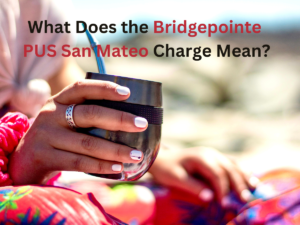In the ever-evolving landscape of telecommunications and utility services, consumers and businesses alike are often confronted with a myriad of charges and fees on their bills. One such charge that has garnered attention, particularly in the San Mateo area, is the “Bridgepointe PUS San Mateo” charge. This article aims to delve into the intricacies of this charge, exploring its origins, purpose, and implications for consumers and businesses in the region.


Understanding the Basics: What is the Bridgepointe PUS San Mateo Charge?
The Bridgepointe PUS San Mateo charge is a fee that appears on the utility bills of residents and businesses in San Mateo, California. The term “PUS” stands for “Public Utility Surcharge,” which is a common designation for additional fees levied by utility providers to cover various costs associated with the delivery of services. In this context, the charge is specifically tied to the Bridgepointe area, a prominent business and retail park located in San Mateo.The Origins of the Bridgepointe PUS San Mateo Charge
To understand the Bridgepointe PUS San Mateo charge, it is essential to explore the historical and regulatory context in which it emerged. The Bridgepointe area, situated in the heart of San Mateo, is a hub for commercial activity, housing numerous businesses, retail outlets, and office spaces. Given its significance as a commercial center, the area requires robust infrastructure to support its operations, including reliable utility services such as electricity, water, and telecommunications. The PUS charge was introduced as a means to fund the maintenance, upgrade, and expansion of the utility infrastructure in the Bridgepointe area. As the demand for utility services in the region grew, utility providers faced increasing pressure to ensure that their infrastructure could meet the needs of the businesses and residents in the area. The PUS charge was thus established to generate the necessary revenue to cover these costs.
The Purpose of the Bridgepointe PUS San Mateo Charge
The primary purpose of the Bridgepointe PUS San Mateo charge is to ensure that the utility infrastructure in the Bridgepointe area remains reliable, efficient, and capable of meeting the growing demands of the region. The funds collected through this charge are typically allocated to various projects and initiatives aimed at improving the quality and reliability of utility services. These projects may include: Infrastructure Upgrades: The PUS charge helps fund the upgrade of aging utility infrastructure, such as power lines, water mains, and telecommunications networks. These upgrades are essential to prevent outages, reduce service disruptions, and ensure that the infrastructure can handle increased demand. Maintenance and Repairs: Regular maintenance and repairs are crucial to keeping utility systems in good working order. The PUS charge provides the necessary funding to carry out these activities, ensuring that the infrastructure remains in optimal condition. Expansion Projects: As the Bridgepointe area continues to grow, there is a need to expand the utility infrastructure to accommodate new businesses and residents. The PUS charge helps finance these expansion projects, ensuring that the region can continue to thrive. Sustainability Initiatives: In recent years, there has been a growing emphasis on sustainability and environmental responsibility. The PUS charge may also be used to fund initiatives aimed at reducing the environmental impact of utility services, such as the adoption of renewable energy sources, energy efficiency programs, and water conservation efforts.The Implications of the Bridgepointe PUS San Mateo Charge
While the Bridgepointe PUS San Mateo charge serves an important purpose, it is not without its implications for consumers and businesses in the area. Understanding these implications is crucial for those who are affected by the charge.For Consumers
For residents of San Mateo, the Bridgepointe PUS charge represents an additional cost on their utility bills. While the charge is typically a relatively small percentage of the total bill, it can still add up over time, particularly for households with high utility usage. It is important for consumers to be aware of this charge and understand how it is calculated. In some cases, consumers may have the option to reduce their overall utility costs by adopting energy-efficient practices or participating in utility-sponsored programs aimed at reducing consumption. By doing so, they can mitigate the impact of the PUS charge on their bills.For Businesses
For businesses operating in the Bridgepointe area, the PUS charge can have a more significant impact. Commercial entities often have higher utility usage compared to residential customers, and as a result, the PUS charge can represent a substantial expense. This is particularly true for businesses that rely heavily on utility services, such as manufacturing facilities, data centers, and large office buildings. To manage the impact of the PUS charge, businesses may need to explore strategies to reduce their utility consumption or negotiate with utility providers for more favorable rates. Additionally, businesses should consider the long-term benefits of investing in energy-efficient technologies and practices, which can help lower utility costs and reduce the impact of the PUS charge.For Utility Providers
For utility providers, the Bridgepointe PUS San Mateo charge is a critical source of revenue that enables them to maintain and improve the utility infrastructure in the area. However, utility providers must also be mindful of the impact that the charge has on their customers. Striking the right balance between generating sufficient revenue to fund infrastructure projects and keeping rates affordable for consumers and businesses is a key challenge. Utility providers may also face scrutiny from regulatory bodies and consumer advocacy groups, who may question the necessity and fairness of the PUS charge. As such, utility providers must be transparent about how the funds collected through the PUS charge are used and demonstrate that the charge is justified by the benefits it provides to the community.
The Regulatory Framework Governing the Bridgepointe PUS San Mateo Charge
The imposition of the Bridgepointe PUS San Mateo charge is subject to regulatory oversight to ensure that it is fair and reasonable. In California, utility rates and charges are regulated by the California Public Utilities Commission (CPUC), which is responsible for overseeing the rates and practices of investor-owned utilities in the state. The CPUC evaluates the necessity of charges such as the PUS and ensures that they are in the public interest. Utility providers must submit detailed proposals and justifications for any new charges or rate increases, and the CPUC conducts a thorough review process before approving them. This process includes opportunities for public input, allowing consumers and businesses to voice their concerns or support for the proposed charges. In the case of the Bridgepointe PUS San Mateo charge, the utility provider would have been required to demonstrate that the charge is necessary to fund essential infrastructure projects and that the benefits of these projects outweigh the costs to consumers and businesses. The CPUC would also assess whether the charge is equitably distributed among customers and whether there are any alternative funding mechanisms that could be used instead.The Future of the Bridgepointe PUS San Mateo Charge
As the Bridgepointe area continues to grow and evolve, the need for reliable and efficient utility services will only increase. The Bridgepointe PUS San Mateo charge is likely to remain a key component of the funding strategy for utility infrastructure in the region. However, the way in which the charge is implemented and managed may change over time in response to shifting priorities and emerging challenges. One potential area of focus for the future is the integration of sustainable and resilient infrastructure. As concerns about climate change and environmental sustainability grow, there may be increased pressure to invest in renewable energy sources, energy storage systems, and other technologies that reduce the environmental impact of utility services. The PUS charge could play a role in funding these initiatives, helping to create a more sustainable and resilient utility infrastructure in the Bridgepointe area. Another consideration for the future is the impact of technological advancements on utility services. The rise of smart grid technologies, distributed energy resources, and other innovations has the potential to transform the way utility services are delivered and consumed. These advancements could lead to more efficient and cost-effective utility systems, potentially reducing the need for certain types of infrastructure investments and, by extension, the PUS charge.What Do the Charges from Bridgepointe PUS San Mateo and Limited Parkway E Reynoldsburg Have in Common?
Both Bridgepointe PUS San Mateo and Limited Parkway E Reynoldsburg share similarities in their service charges, reflecting common billing practices across various establishments. Understanding these charges can simplify budgeting. For a detailed breakdown, see the “limited parkway e charge explained” to clarify costs associated with these locations.
